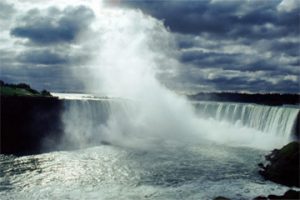Water surrounds us, falling from the sky, rushing down riverbeds, pouring from faucets, and yet many of us have never stopped to ask where it comes from. The answer is a complicated one, stretching way beyond an incoming tide or a cloud heavy with rain and all the way back to the very origins of the universe.
Shortly after the big bang, protons, neutrons and electrons swarmed in 10 billion degree heat. Within minutes, hydrogen and then helium, known as the lighter elements, had taken shape from these atomic building blocks in a process called nucleosynthesis. (Lithium had a cameo as well.) The heavier elements didn’t appear until much later, when the lighter elements underwent fusion inside of stars and during supernovas. Over time, stars sent wave after wave of these heavier elements, including oxygen, out into space where they mixed with the lighter elements.
Of course, the formation of hydrogen and oxygen molecules and the subsequent formation of water are two different things. That’s because even when hydrogen and oxygen molecules mix, they still need a spark of energy to form water. The process is a violent one, and so far nobody has found a way to safely create water on Earth.
So how did our planet come to be covered with oceans, lakes and rivers? The simple answer is we still don’t know, but we have theories. One theory states that, nearly 4 billion years ago, millions of asteroids and comets slammed into the Earth’s surface; a quick glance at the moon’s crater-pocked surface gives us an idea of what conditions were like. The theory goes that these weren’t normal rocks but rather the equivalent of cosmic sponges, loaded with water that was released on impact.
While astronomers have confirmed that some asteroids and comets hold water, some scientists think the theory doesn’t. For one thing, scientists still haven’t found any remnants of the comets and asteroids. What’s more, they question whether enough collisions could have taken place to account for all of the water in Earth’s oceans. Finally, researchers from the California Institute of Technology found that water from the comet Hale-Bopp contains much more heavy water (which has more deuterium) than Earth’s oceans, meaning either the comets and asteroids that hit Earth were very different than Hale-Bopp, or Earth got its water some other way.
Another recent theory states that a young Earth was bombarded by oxygen and other heavy elements produced within the sun. The oxygen combined with hydrogen and other gases released from the Earth in a process known as degassing, forming the Earth’s oceans and atmosphere along the way.
A team of scientists from Japan’s Tokyo Institute of Technology has devised yet another theory, which states that a thick layer of hydrogen may have once covered the Earth’s surface, eventually interacting with oxides in the crust to form our planet’s oceans.
And so, while we can’t say with certainty how water came to Earth, we can say we’re fortunate it did.
Source: https://science.howstuffworks.com/
Dear User/Visitor! Please, answer on our questions: tick off one of the positions – your answer will make us able to improve our site and make it more interesting and useful!


